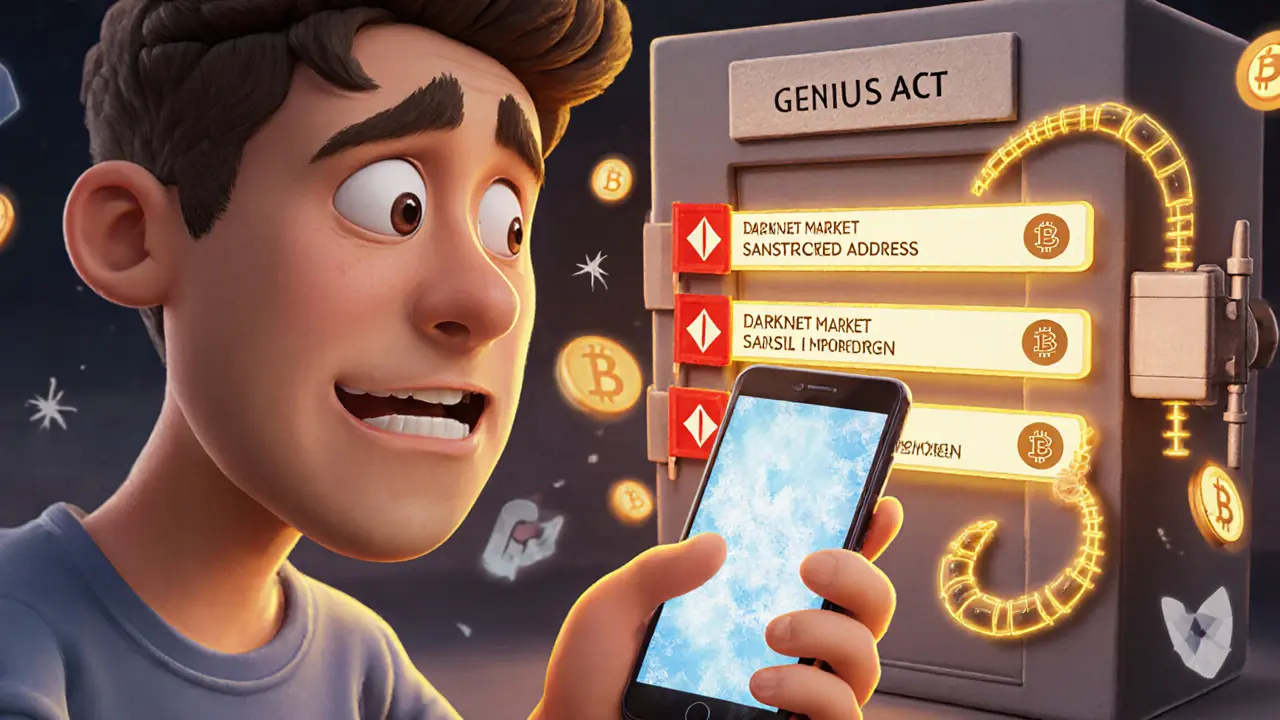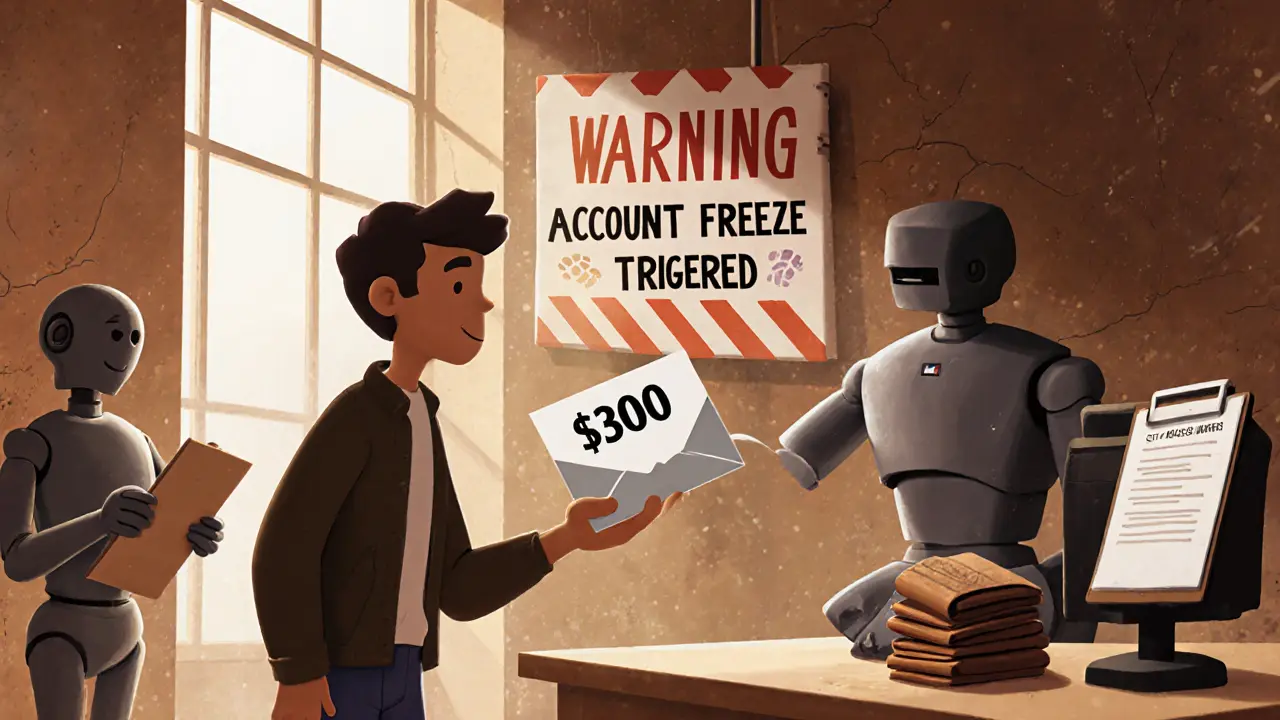Why Your Bank Account Is Freezing Over Crypto Activity in 2025
 Jul, 28 2025
Jul, 28 2025
Crypto Account Freeze Risk Calculator
How Risky Is Your Crypto Activity?
This tool helps you assess your risk of bank account freezing based on 2025 GENIUS Act regulations. Select all scenarios that apply to your crypto activity:
Your Risk Assessment
- Use only KYC-compliant exchanges (Coinbase, Kraken, Gemini)
- Verify identities before accepting crypto payments
- Keep separate wallets for different purposes
- Use stablecoins from approved issuers (USDC, USDT)
If your bank account suddenly froze after you bought, sold, or received cryptocurrency, you’re not alone. In 2025, bank account freezing for crypto activity has become one of the most common-and confusing-financial surprises people face. You didn’t commit fraud. You didn’t launder money. You just bought Bitcoin on Coinbase or got paid in ETH for freelance work. Yet your bank blocked everything: no deposits, no withdrawals, no transfers. And they won’t tell you why.
Why Banks Freeze Accounts Over Crypto
Banks aren’t acting out of spite. They’re following federal rules that changed dramatically in mid-2025. The GENIUS Act is a federal law signed in June 2025 that gave banks legal authority to freeze accounts tied to cryptocurrency transactions involving high-risk addresses. This law doesn’t require proof you did anything wrong. It only requires that your transaction history connects-directly or indirectly-to a flagged address on the blockchain.Here’s how it works: blockchain transactions are public. If someone you never met sent crypto to your wallet from a darknet market, a sanctioned Russian address, or a mixing service, that transaction leaves a digital fingerprint. Banks use tools like Chainalysis, Elliptic, and TRM Labs to scan every incoming crypto deposit. If the system flags the source address-even if it’s five steps removed from you-the bank is legally required to freeze your account until you prove the funds are clean.
It’s not about your behavior. It’s about the history of the money. And that’s what makes it so frustrating. You didn’t know the sender had a shady past. You didn’t ask. But under the GENIUS Act, ignorance isn’t a defense.
What Triggers a Freeze in 2025
Not all crypto activity causes a freeze. But these six scenarios are the most common triggers:- Receiving crypto from an address previously linked to a darknet marketplace (like past Silk Road or Hydra addresses)
- Depositing funds from a crypto exchange that was flagged by FinCEN for weak KYC
- Using a privacy coin like Monero or Zcash, which banks treat as high-risk by default
- Getting paid in crypto from a client who received payment from a sanctioned entity
- Using a crypto-to-fiat off-ramp service that’s not on your bank’s approved vendor list
- Transferring crypto from a non-KYC wallet (like a hardware wallet with no identity tied to it)
Even if you’ve never used a mixing service or traded on an unregulated exchange, your account can still get caught in the net. That’s because blockchain is a chain. One bad link can freeze your whole account.
How Banks Detect Suspicious Activity
Banks don’t guess. They use automated systems that analyze millions of blockchain transactions daily. These tools map out the flow of funds across wallets, exchanges, and protocols. They don’t care if you’re a freelancer, a small business owner, or an investor. If the path of your crypto traces back to a known bad actor-even indirectly-the system triggers a freeze.These systems are called Know Your Transaction (KYT) platforms. They’re built into the core compliance software banks use to meet Bank Secrecy Act (BSA) and Anti-Money Laundering (AML) requirements. In 2025, the Federal Deposit Insurance Corporation (FDIC) updated its guidance to explicitly require banks to use KYT tools for all crypto-related activity. The result? Banks now scan every crypto deposit like a bomb-sniffing dog.
What’s worse? These systems don’t distinguish between small and large transactions. A $50 payment from a crypto gig can trigger the same freeze as a $50,000 transfer. The system doesn’t care about intent. It only cares about the address history.

The Legal Gray Zone
There’s a major contradiction in the system. On one hand, big banks like JPMorgan Chase, Bank of America, and Wells Fargo are launching their own stablecoin projects. They’re investing millions in crypto infrastructure. On the other hand, your personal account gets frozen for receiving $300 in USDC from a client who got paid in crypto from someone else.This is the “bifurcated market” experts talk about. Institutions get regulatory clarity. Individuals get caught in the crossfire.
The GENIUS Act explicitly exempts stablecoins from securities regulation-but only if they’re issued by approved entities. That means if you’re using USDT or USDC from Tether or Circle, you’re fine… unless the address you received it from has a tainted history. Then it doesn’t matter who issued it. The address is the problem.
And here’s the kicker: the law doesn’t require banks to give you a clear reason for the freeze. They just say “compliance review.” No timeline. No explanation. No appeal process built into their system. You’re stuck waiting while your rent money sits locked up.
What You Can Do When Your Account Is Frozen
If your account is frozen, here’s what actually works-not the generic advice you find online.- Don’t panic. Don’t withdraw or move funds. Any new activity makes it worse.
- Request a written explanation. Call your bank’s compliance department (not customer service) and ask for a copy of the “lawful order” or “AML alert” that triggered the freeze. They’re legally required to provide it.
- Collect transaction records. Export your full crypto transaction history from your wallet and exchange. Include dates, addresses, amounts, and transaction IDs.
- Use a blockchain explorer. Paste the source address into Etherscan or Blockchain.com Explorer. See if it’s flagged by Chainalysis or Elliptic. Take screenshots.
- Submit a formal appeal. Most banks have a crypto compliance appeals form. Fill it out with your documentation. Include a sworn statement: “I did not knowingly engage with illicit activity.”
- Escalate to the bank’s ombudsman. If they don’t respond in 30 days, ask for the bank’s internal ombudsman. They have authority to override compliance decisions.
Many people get their accounts unfrozen within 45 to 90 days if they provide clear, documented proof. But if you don’t have records? You’re at the mercy of the bank’s internal review cycle-which can take six months or longer.

How to Avoid a Freeze Before It Happens
Prevention is your best defense. Here’s how to stay safe in 2025:- Only use KYC-compliant exchanges. Stick to Coinbase, Kraken, Gemini. Avoid decentralized exchanges (DEXs) for cash-outs.
- Never accept crypto from strangers. If someone pays you in crypto, verify their identity first. Use a platform like BitPay or Coinbase Commerce that handles KYC for you.
- Keep clean wallets. Use a separate wallet for receiving payments. Don’t mix personal, business, and trading funds.
- Document everything. Save emails, contracts, and invoices tied to every crypto payment you receive.
- Avoid privacy coins. Monero, Zcash, and Dash are automatic red flags. Stick to Bitcoin and Ethereum-based tokens.
- Use stablecoins from approved issuers. USDC (Circle) and USDT (Tether) are safer than lesser-known stablecoins.
And if you’re a freelancer or small business? Consider switching to fiat-only payment platforms. The risk of a freeze isn’t worth the 1-2% savings on fees.
What’s Next for Crypto and Banks
The GENIUS Act is just the beginning. In late 2025, the Senate is expected to pass the CLARITY Act, which will require all crypto transactions over $10,000 to be reported to FinCEN. That’s like a crypto version of the Currency and Foreign Transactions Reporting Act.At the same time, banks are building internal crypto compliance teams. One mid-sized bank in Colorado hired 12 new compliance officers just to handle crypto freezes. Their training? Blockchain forensics, wallet clustering, and transaction graph analysis.
The message is clear: if you want to use crypto and keep your bank account, you need to treat it like a regulated financial product-not a tech experiment. The days of “just send crypto and hope for the best” are over.
For many, the answer is moving to DeFi. But that comes with its own risks-no FDIC insurance, no customer support, no recourse if you get hacked. It’s a trade-off: freedom vs. protection.
Final Reality Check
This isn’t a glitch. It’s the new normal. The U.S. government has chosen to prioritize financial crime prevention over user convenience in the crypto space. And banks, facing billions in potential fines, have no choice but to lock down accounts aggressively.If you’re using crypto for legitimate reasons, you’re not the target. But you’re still collateral damage. The system doesn’t care if you’re innocent. It only cares if the money has a dirty past.
Your best move? Play it safe. Document everything. Use trusted platforms. And assume every crypto transaction could trigger a freeze-until you prove otherwise.
Kristi Malicsi
November 27, 2025 AT 16:33no one asked for this. no one signed up for this. but here we are, punished for the sins of strangers.
Rachel Thomas
November 27, 2025 AT 18:27